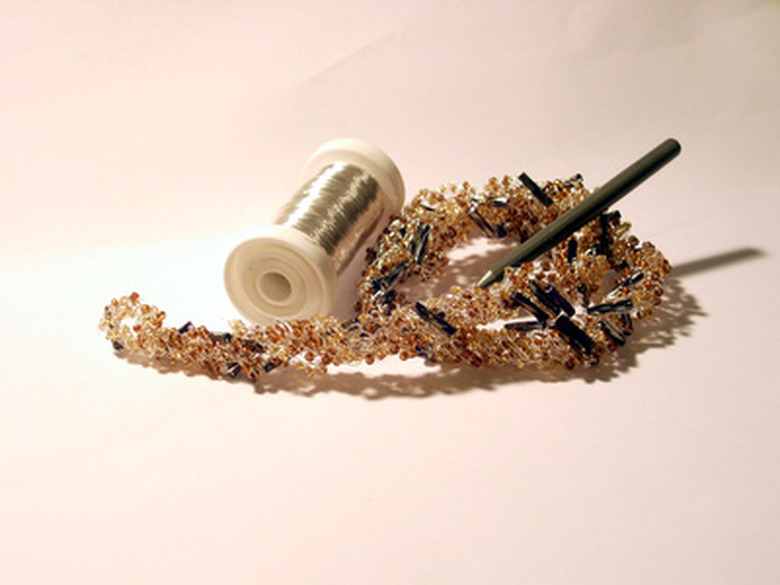How To Make A Styrofoam Potassium Atom For School
All atoms are made up of three main parts; protons, neutrons and electrons. The protons and neutrons are found in the nucleus of the atom. The electrons orbit the nucleus in energy levels or shells. Before constructing your model, you need to determine how many protons, neutrons and electrons are present in the atom potassium. The number of protons and electrons are equal to the element's atomic number. The number of neutrons is equal to number of protons subtracted from the atomic weight of the potassium atom.
Step 1
Determine the number of protons, neutrons and electrons found in the potassium atom. Do this by consulting a periodic table. You must use a periodic table which includes the atomic weight of each element, such as the one recommended by the Commission on the Nomenclature of Inorganic Chemistry. Potassium is represented by the letter K on the periodic table. The number above the letter K is the atomic number for Potassium, which is 19. This is the number of protons and electrons found in potassium. Subtract the number 19 from the atomic weight (rounded to the nearest whole number), found below the letter K, and you get the number 20. There are 20 neutrons in the nucleus of potassium.
Step 2
Glue 19 red hard-shelled candies anywhere on the 4-inch Styrofoam ball. The Styrofoam ball represents the nucleus. The 19 red candies represent the 19 protons found in the nucleus.
Step 3
Glue 20 blue hard-shelled candies anywhere on the 4-inch Styrofoam ball. The blue candies represent the neutrons in the nucleus of the potassium atom.
Step 4
Push the 18-inch piece of craft wire through two of the 1-inch styrofoam balls. Bend the wire in the shape of a circle and twist the ends together. This represents the first full energy level of potassium.
Step 5
Push the 24-inch piece of craft wire through 8 1-inch Styrofoam balls. Twist the edges of the wire together to form a circle. Spread the eight balls out around the entire circle. This represents the second complete energy level for potassium.
Step 6
Push 8 Styrofoam balls through the 30-inch piece of craft wire. Twist the ends to form a circle with the wire. Spread the balls out around the circle. This represents the third complete energy level of potassium.
Step 7
Push the 36-inch piece of craft wire through one Styrofoam ball. Twist the ends of the wire together to form a circle. This represents the last energy level of potassium. It is not complete, as it has only one electron. This incompletness gives potassium the charge of +1.
Step 8
Bend the 4-inch piece of craft wire into the shape of the letter U. Place the open end into the nucleus, or 4-inch craft ball, leaving 1/2 inch of the loop sticking out.
Step 9
Lay the nucleus on a flat surface. Around the nucleus, place the energy level with two electrons, then both energy levels with eight electrons, and finally the energy level with only one electron. They should follow an order with the smallest being the closest to the nucleus and the largest being furthest from the nucleus.
Step 10
Cut a piece of fishing line 12 inches longer than the size of your potassium atom from nucleus to the incomplete energy level. Thread the fishing line through the wire loop on the nucleus. Pull the fishing line up to the next wire circle and double knot the fishing line onto that circle. Continue to do this until you tie all four energy levels and the nucleus together. Use the extra fishing line to tie the potassium atom to a hook for display, if wanted.
Things Needed
- Periodic table
- Craft glue
- 19 red hard-shelled candies
- 20 blue hard-shelled candies
- 1 4-inch Styrofoam ball
- 19 1-inch Styrofoam balls
- Craft wire cut to 4, 18, 24, 30 and 36-inch pieces
- Fishing wire
- Hook for display
TL;DR (Too Long; Didn't Read)
This create a large model of a potassium atom. Use a smaller Styrofoam ball for the nucleus and shorter pieces of craft wire strung with jelly beans or cotton balls for the electrons to make a smaller sized model.
References
Cite This Article
MLA
Shelleby, Amy. "How To Make A Styrofoam Potassium Atom For School" sciencing.com, https://www.sciencing.com/make-styrofoam-potassium-atom-school-7739359/. 24 April 2017.
APA
Shelleby, Amy. (2017, April 24). How To Make A Styrofoam Potassium Atom For School. sciencing.com. Retrieved from https://www.sciencing.com/make-styrofoam-potassium-atom-school-7739359/
Chicago
Shelleby, Amy. How To Make A Styrofoam Potassium Atom For School last modified March 24, 2022. https://www.sciencing.com/make-styrofoam-potassium-atom-school-7739359/
